Innovation and Creativity in Tourism and Hospitality Industries
VerifiedAdded on 2023/01/20
|9
|2310
|48
Report
AI Summary
This report critically examines the concepts of innovation and creativity within the contemporary tourism and hospitality industries. It explores how organizations are adapting to a dynamic environment, emphasizing the importance of innovation for maintaining a competitive advantage. The report discusses the relationship between creativity and innovation, highlighting how creativity fuels the generation of new ideas that drive innovation. It delves into the impact of technology, such as online booking systems and SaaS, on the industry's evolution and the emergence of the blue ocean strategy. Key trends and innovations are analyzed, including easy check-ins and online booking, and their positive effects on both tourism and hospitality sectors are discussed. The report concludes that creativity and innovation are essential for survival and success in today's highly competitive environment, with various challenges that organizations face.
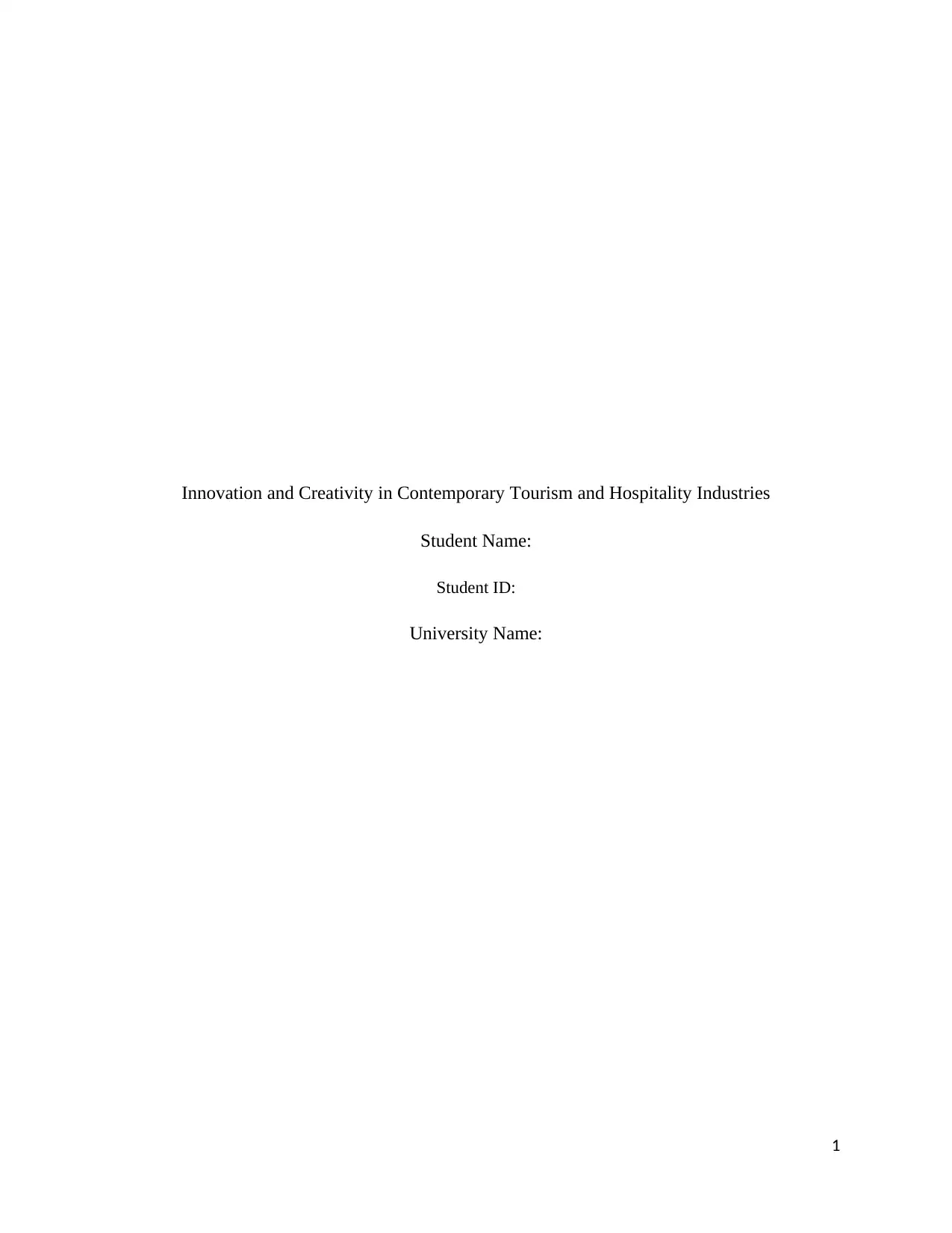
Innovation and Creativity in Contemporary Tourism and Hospitality Industries
Student Name:
Student ID:
University Name:
1
Student Name:
Student ID:
University Name:
1
Paraphrase This Document
Need a fresh take? Get an instant paraphrase of this document with our AI Paraphraser
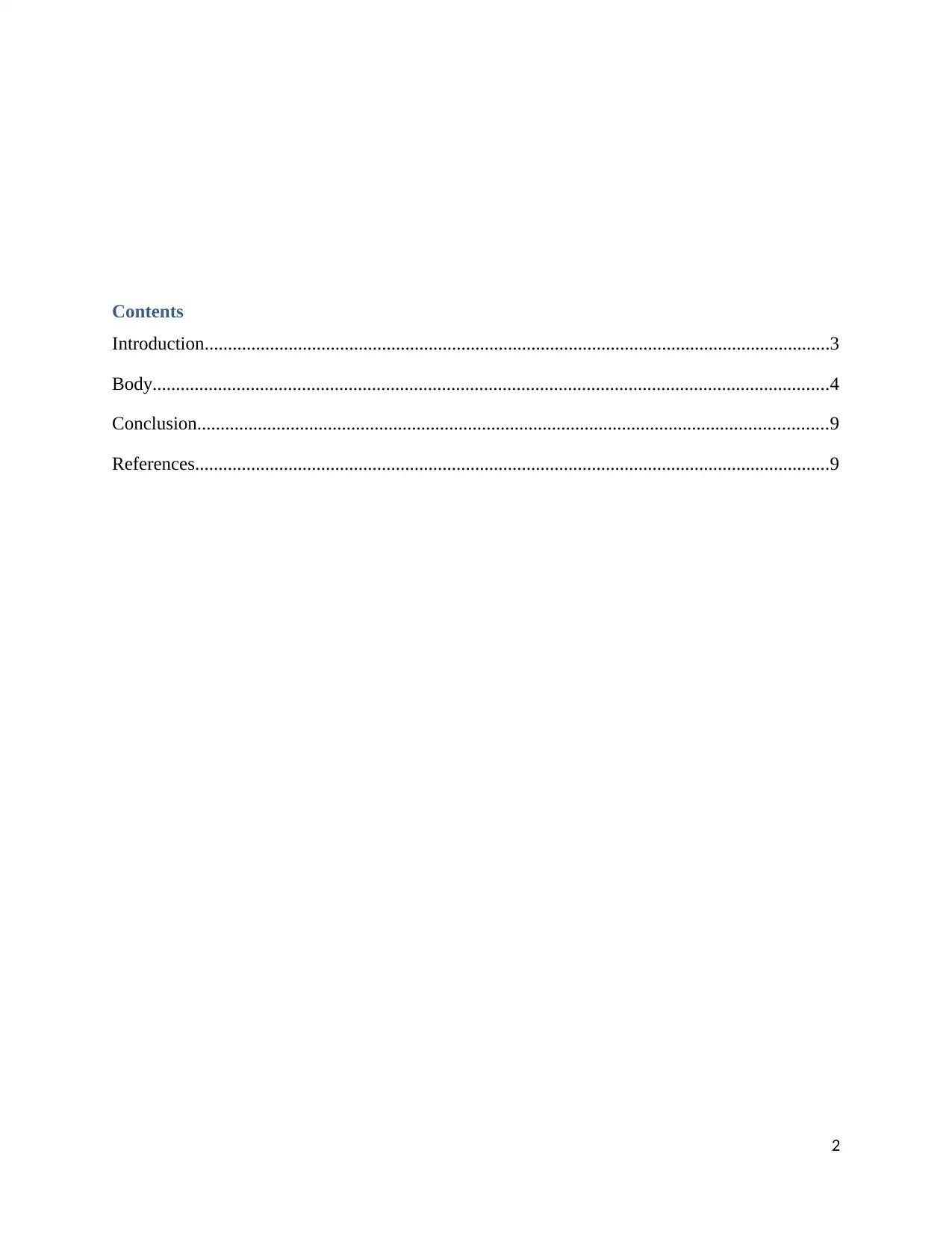
Contents
Introduction......................................................................................................................................3
Body.................................................................................................................................................4
Conclusion.......................................................................................................................................9
References........................................................................................................................................9
2
Introduction......................................................................................................................................3
Body.................................................................................................................................................4
Conclusion.......................................................................................................................................9
References........................................................................................................................................9
2
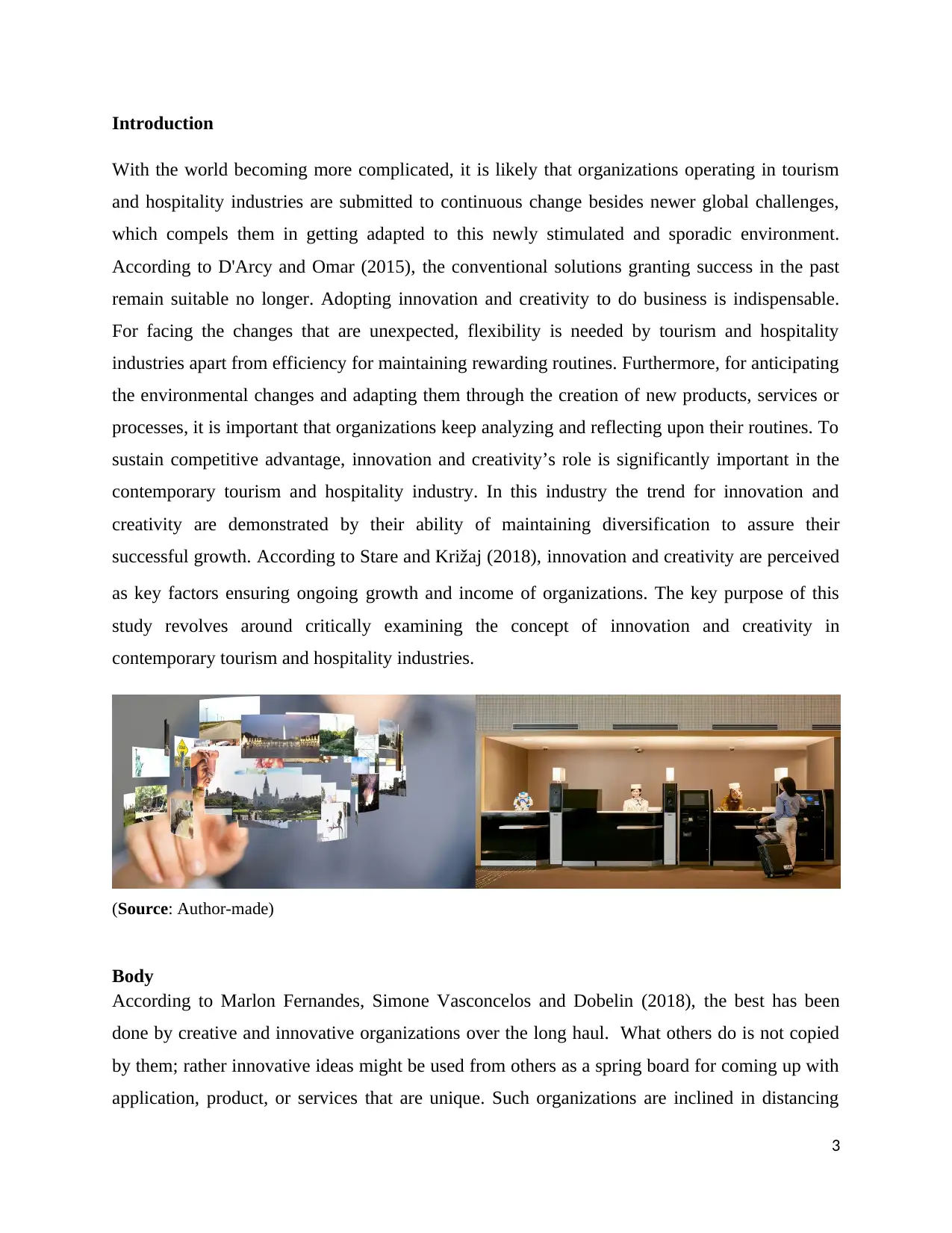
Introduction
With the world becoming more complicated, it is likely that organizations operating in tourism
and hospitality industries are submitted to continuous change besides newer global challenges,
which compels them in getting adapted to this newly stimulated and sporadic environment.
According to D'Arcy and Omar (2015), the conventional solutions granting success in the past
remain suitable no longer. Adopting innovation and creativity to do business is indispensable.
For facing the changes that are unexpected, flexibility is needed by tourism and hospitality
industries apart from efficiency for maintaining rewarding routines. Furthermore, for anticipating
the environmental changes and adapting them through the creation of new products, services or
processes, it is important that organizations keep analyzing and reflecting upon their routines. To
sustain competitive advantage, innovation and creativity’s role is significantly important in the
contemporary tourism and hospitality industry. In this industry the trend for innovation and
creativity are demonstrated by their ability of maintaining diversification to assure their
successful growth. According to Stare and Križaj (2018), innovation and creativity are perceived
as key factors ensuring ongoing growth and income of organizations. The key purpose of this
study revolves around critically examining the concept of innovation and creativity in
contemporary tourism and hospitality industries.
(Source: Author-made)
Body
According to Marlon Fernandes, Simone Vasconcelos and Dobelin (2018), the best has been
done by creative and innovative organizations over the long haul. What others do is not copied
by them; rather innovative ideas might be used from others as a spring board for coming up with
application, product, or services that are unique. Such organizations are inclined in distancing
3
With the world becoming more complicated, it is likely that organizations operating in tourism
and hospitality industries are submitted to continuous change besides newer global challenges,
which compels them in getting adapted to this newly stimulated and sporadic environment.
According to D'Arcy and Omar (2015), the conventional solutions granting success in the past
remain suitable no longer. Adopting innovation and creativity to do business is indispensable.
For facing the changes that are unexpected, flexibility is needed by tourism and hospitality
industries apart from efficiency for maintaining rewarding routines. Furthermore, for anticipating
the environmental changes and adapting them through the creation of new products, services or
processes, it is important that organizations keep analyzing and reflecting upon their routines. To
sustain competitive advantage, innovation and creativity’s role is significantly important in the
contemporary tourism and hospitality industry. In this industry the trend for innovation and
creativity are demonstrated by their ability of maintaining diversification to assure their
successful growth. According to Stare and Križaj (2018), innovation and creativity are perceived
as key factors ensuring ongoing growth and income of organizations. The key purpose of this
study revolves around critically examining the concept of innovation and creativity in
contemporary tourism and hospitality industries.
(Source: Author-made)
Body
According to Marlon Fernandes, Simone Vasconcelos and Dobelin (2018), the best has been
done by creative and innovative organizations over the long haul. What others do is not copied
by them; rather innovative ideas might be used from others as a spring board for coming up with
application, product, or services that are unique. Such organizations are inclined in distancing
3
⊘ This is a preview!⊘
Do you want full access?
Subscribe today to unlock all pages.

Trusted by 1+ million students worldwide
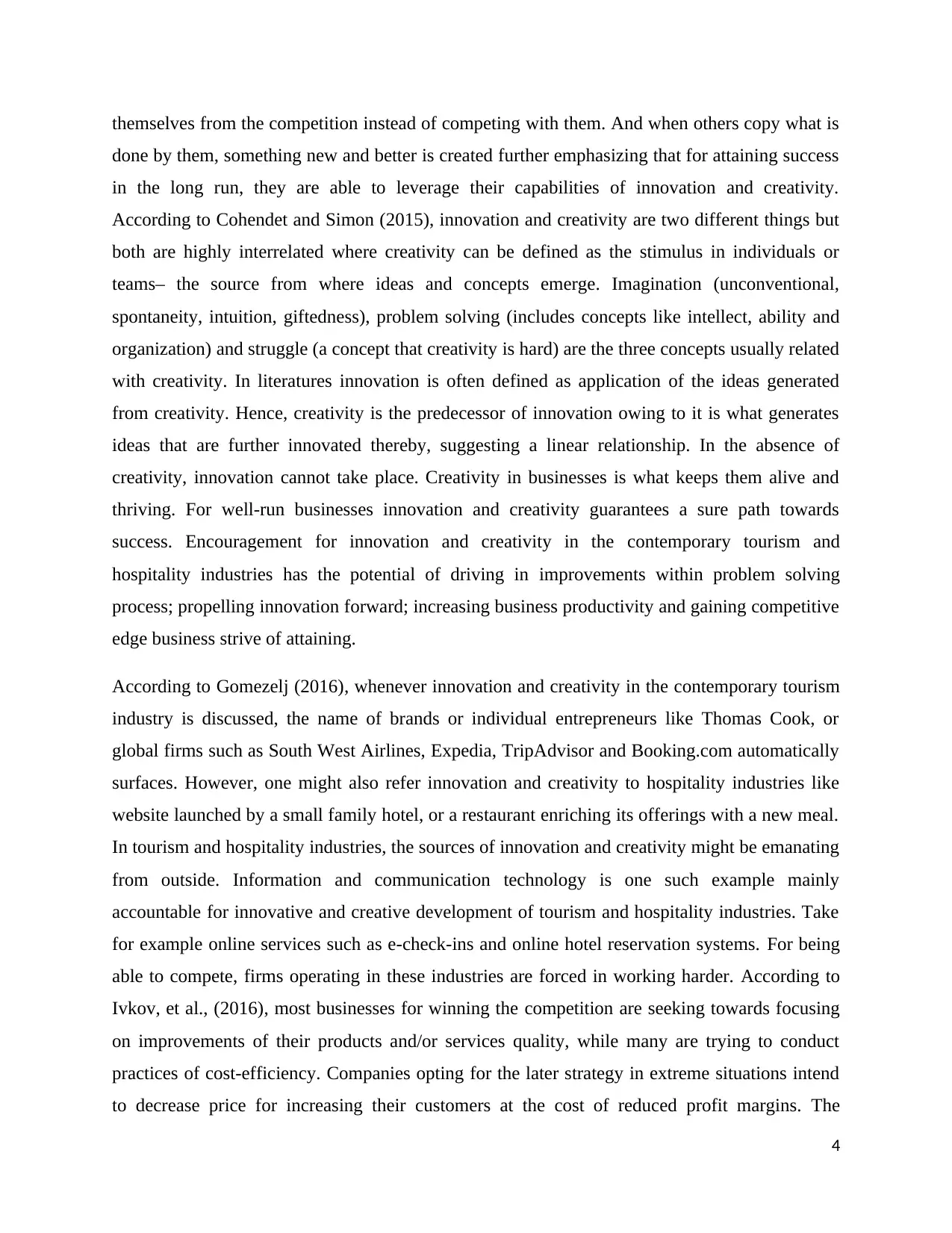
themselves from the competition instead of competing with them. And when others copy what is
done by them, something new and better is created further emphasizing that for attaining success
in the long run, they are able to leverage their capabilities of innovation and creativity.
According to Cohendet and Simon (2015), innovation and creativity are two different things but
both are highly interrelated where creativity can be defined as the stimulus in individuals or
teams– the source from where ideas and concepts emerge. Imagination (unconventional,
spontaneity, intuition, giftedness), problem solving (includes concepts like intellect, ability and
organization) and struggle (a concept that creativity is hard) are the three concepts usually related
with creativity. In literatures innovation is often defined as application of the ideas generated
from creativity. Hence, creativity is the predecessor of innovation owing to it is what generates
ideas that are further innovated thereby, suggesting a linear relationship. In the absence of
creativity, innovation cannot take place. Creativity in businesses is what keeps them alive and
thriving. For well-run businesses innovation and creativity guarantees a sure path towards
success. Encouragement for innovation and creativity in the contemporary tourism and
hospitality industries has the potential of driving in improvements within problem solving
process; propelling innovation forward; increasing business productivity and gaining competitive
edge business strive of attaining.
According to Gomezelj (2016), whenever innovation and creativity in the contemporary tourism
industry is discussed, the name of brands or individual entrepreneurs like Thomas Cook, or
global firms such as South West Airlines, Expedia, TripAdvisor and Booking.com automatically
surfaces. However, one might also refer innovation and creativity to hospitality industries like
website launched by a small family hotel, or a restaurant enriching its offerings with a new meal.
In tourism and hospitality industries, the sources of innovation and creativity might be emanating
from outside. Information and communication technology is one such example mainly
accountable for innovative and creative development of tourism and hospitality industries. Take
for example online services such as e-check-ins and online hotel reservation systems. For being
able to compete, firms operating in these industries are forced in working harder. According to
Ivkov, et al., (2016), most businesses for winning the competition are seeking towards focusing
on improvements of their products and/or services quality, while many are trying to conduct
practices of cost-efficiency. Companies opting for the later strategy in extreme situations intend
to decrease price for increasing their customers at the cost of reduced profit margins. The
4
done by them, something new and better is created further emphasizing that for attaining success
in the long run, they are able to leverage their capabilities of innovation and creativity.
According to Cohendet and Simon (2015), innovation and creativity are two different things but
both are highly interrelated where creativity can be defined as the stimulus in individuals or
teams– the source from where ideas and concepts emerge. Imagination (unconventional,
spontaneity, intuition, giftedness), problem solving (includes concepts like intellect, ability and
organization) and struggle (a concept that creativity is hard) are the three concepts usually related
with creativity. In literatures innovation is often defined as application of the ideas generated
from creativity. Hence, creativity is the predecessor of innovation owing to it is what generates
ideas that are further innovated thereby, suggesting a linear relationship. In the absence of
creativity, innovation cannot take place. Creativity in businesses is what keeps them alive and
thriving. For well-run businesses innovation and creativity guarantees a sure path towards
success. Encouragement for innovation and creativity in the contemporary tourism and
hospitality industries has the potential of driving in improvements within problem solving
process; propelling innovation forward; increasing business productivity and gaining competitive
edge business strive of attaining.
According to Gomezelj (2016), whenever innovation and creativity in the contemporary tourism
industry is discussed, the name of brands or individual entrepreneurs like Thomas Cook, or
global firms such as South West Airlines, Expedia, TripAdvisor and Booking.com automatically
surfaces. However, one might also refer innovation and creativity to hospitality industries like
website launched by a small family hotel, or a restaurant enriching its offerings with a new meal.
In tourism and hospitality industries, the sources of innovation and creativity might be emanating
from outside. Information and communication technology is one such example mainly
accountable for innovative and creative development of tourism and hospitality industries. Take
for example online services such as e-check-ins and online hotel reservation systems. For being
able to compete, firms operating in these industries are forced in working harder. According to
Ivkov, et al., (2016), most businesses for winning the competition are seeking towards focusing
on improvements of their products and/or services quality, while many are trying to conduct
practices of cost-efficiency. Companies opting for the later strategy in extreme situations intend
to decrease price for increasing their customers at the cost of reduced profit margins. The
4
Paraphrase This Document
Need a fresh take? Get an instant paraphrase of this document with our AI Paraphraser
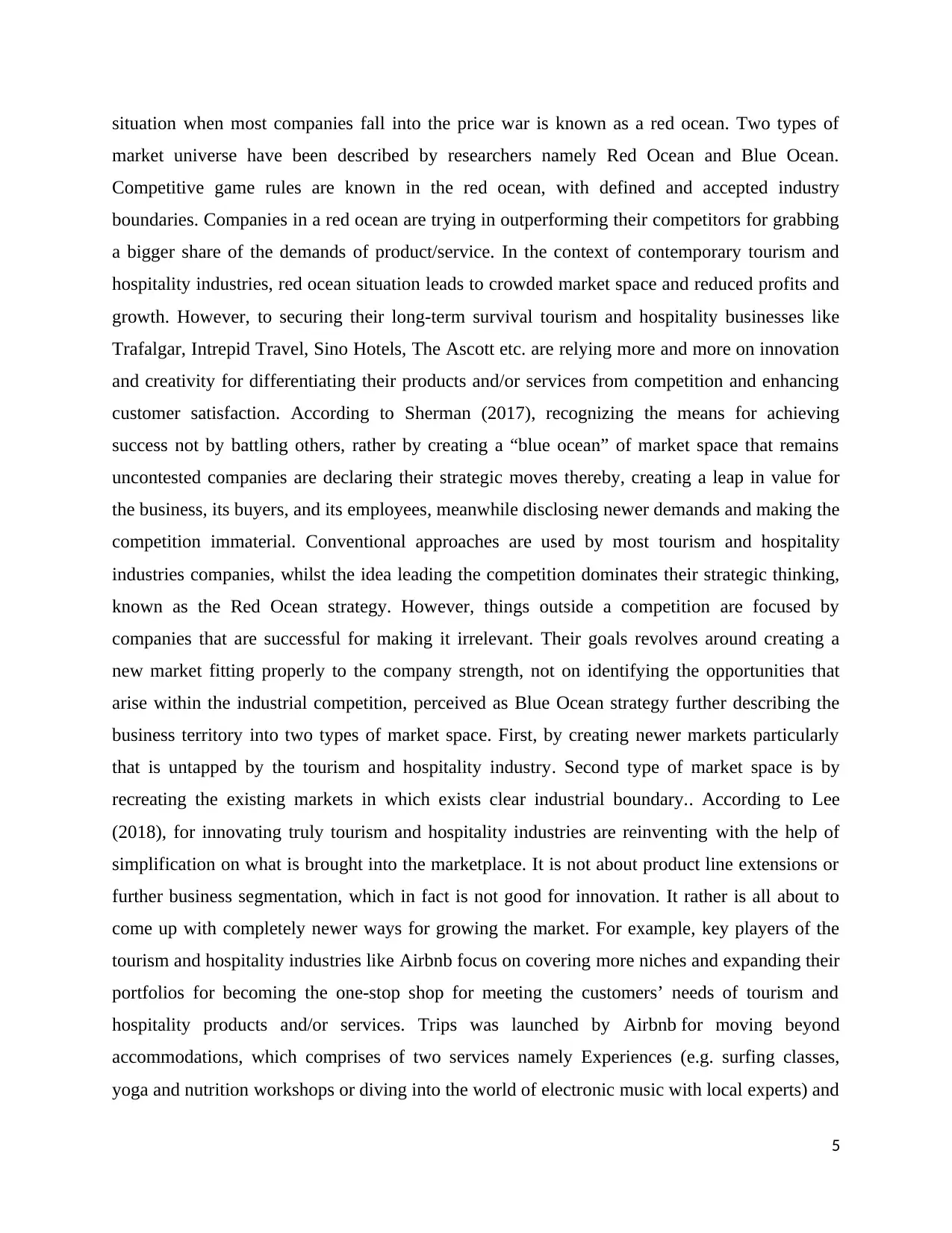
situation when most companies fall into the price war is known as a red ocean. Two types of
market universe have been described by researchers namely Red Ocean and Blue Ocean.
Competitive game rules are known in the red ocean, with defined and accepted industry
boundaries. Companies in a red ocean are trying in outperforming their competitors for grabbing
a bigger share of the demands of product/service. In the context of contemporary tourism and
hospitality industries, red ocean situation leads to crowded market space and reduced profits and
growth. However, to securing their long-term survival tourism and hospitality businesses like
Trafalgar, Intrepid Travel, Sino Hotels, The Ascott etc. are relying more and more on innovation
and creativity for differentiating their products and/or services from competition and enhancing
customer satisfaction. According to Sherman (2017), recognizing the means for achieving
success not by battling others, rather by creating a “blue ocean” of market space that remains
uncontested companies are declaring their strategic moves thereby, creating a leap in value for
the business, its buyers, and its employees, meanwhile disclosing newer demands and making the
competition immaterial. Conventional approaches are used by most tourism and hospitality
industries companies, whilst the idea leading the competition dominates their strategic thinking,
known as the Red Ocean strategy. However, things outside a competition are focused by
companies that are successful for making it irrelevant. Their goals revolves around creating a
new market fitting properly to the company strength, not on identifying the opportunities that
arise within the industrial competition, perceived as Blue Ocean strategy further describing the
business territory into two types of market space. First, by creating newer markets particularly
that is untapped by the tourism and hospitality industry. Second type of market space is by
recreating the existing markets in which exists clear industrial boundary.. According to Lee
(2018), for innovating truly tourism and hospitality industries are reinventing with the help of
simplification on what is brought into the marketplace. It is not about product line extensions or
further business segmentation, which in fact is not good for innovation. It rather is all about to
come up with completely newer ways for growing the market. For example, key players of the
tourism and hospitality industries like Airbnb focus on covering more niches and expanding their
portfolios for becoming the one-stop shop for meeting the customers’ needs of tourism and
hospitality products and/or services. Trips was launched by Airbnb for moving beyond
accommodations, which comprises of two services namely Experiences (e.g. surfing classes,
yoga and nutrition workshops or diving into the world of electronic music with local experts) and
5
market universe have been described by researchers namely Red Ocean and Blue Ocean.
Competitive game rules are known in the red ocean, with defined and accepted industry
boundaries. Companies in a red ocean are trying in outperforming their competitors for grabbing
a bigger share of the demands of product/service. In the context of contemporary tourism and
hospitality industries, red ocean situation leads to crowded market space and reduced profits and
growth. However, to securing their long-term survival tourism and hospitality businesses like
Trafalgar, Intrepid Travel, Sino Hotels, The Ascott etc. are relying more and more on innovation
and creativity for differentiating their products and/or services from competition and enhancing
customer satisfaction. According to Sherman (2017), recognizing the means for achieving
success not by battling others, rather by creating a “blue ocean” of market space that remains
uncontested companies are declaring their strategic moves thereby, creating a leap in value for
the business, its buyers, and its employees, meanwhile disclosing newer demands and making the
competition immaterial. Conventional approaches are used by most tourism and hospitality
industries companies, whilst the idea leading the competition dominates their strategic thinking,
known as the Red Ocean strategy. However, things outside a competition are focused by
companies that are successful for making it irrelevant. Their goals revolves around creating a
new market fitting properly to the company strength, not on identifying the opportunities that
arise within the industrial competition, perceived as Blue Ocean strategy further describing the
business territory into two types of market space. First, by creating newer markets particularly
that is untapped by the tourism and hospitality industry. Second type of market space is by
recreating the existing markets in which exists clear industrial boundary.. According to Lee
(2018), for innovating truly tourism and hospitality industries are reinventing with the help of
simplification on what is brought into the marketplace. It is not about product line extensions or
further business segmentation, which in fact is not good for innovation. It rather is all about to
come up with completely newer ways for growing the market. For example, key players of the
tourism and hospitality industries like Airbnb focus on covering more niches and expanding their
portfolios for becoming the one-stop shop for meeting the customers’ needs of tourism and
hospitality products and/or services. Trips was launched by Airbnb for moving beyond
accommodations, which comprises of two services namely Experiences (e.g. surfing classes,
yoga and nutrition workshops or diving into the world of electronic music with local experts) and
5
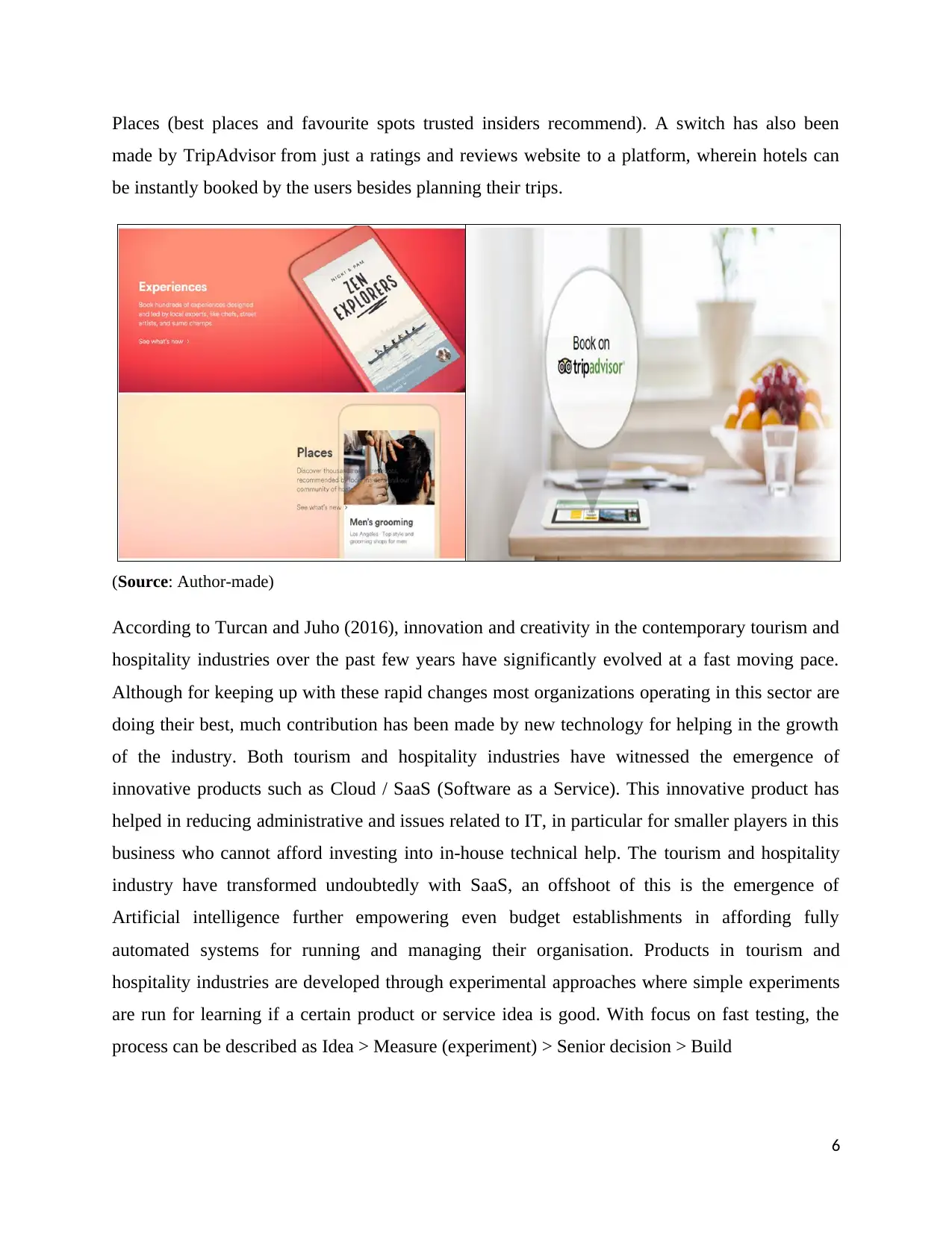
Places (best places and favourite spots trusted insiders recommend). A switch has also been
made by TripAdvisor from just a ratings and reviews website to a platform, wherein hotels can
be instantly booked by the users besides planning their trips.
(Source: Author-made)
According to Turcan and Juho (2016), innovation and creativity in the contemporary tourism and
hospitality industries over the past few years have significantly evolved at a fast moving pace.
Although for keeping up with these rapid changes most organizations operating in this sector are
doing their best, much contribution has been made by new technology for helping in the growth
of the industry. Both tourism and hospitality industries have witnessed the emergence of
innovative products such as Cloud / SaaS (Software as a Service). This innovative product has
helped in reducing administrative and issues related to IT, in particular for smaller players in this
business who cannot afford investing into in-house technical help. The tourism and hospitality
industry have transformed undoubtedly with SaaS, an offshoot of this is the emergence of
Artificial intelligence further empowering even budget establishments in affording fully
automated systems for running and managing their organisation. Products in tourism and
hospitality industries are developed through experimental approaches where simple experiments
are run for learning if a certain product or service idea is good. With focus on fast testing, the
process can be described as Idea > Measure (experiment) > Senior decision > Build
6
made by TripAdvisor from just a ratings and reviews website to a platform, wherein hotels can
be instantly booked by the users besides planning their trips.
(Source: Author-made)
According to Turcan and Juho (2016), innovation and creativity in the contemporary tourism and
hospitality industries over the past few years have significantly evolved at a fast moving pace.
Although for keeping up with these rapid changes most organizations operating in this sector are
doing their best, much contribution has been made by new technology for helping in the growth
of the industry. Both tourism and hospitality industries have witnessed the emergence of
innovative products such as Cloud / SaaS (Software as a Service). This innovative product has
helped in reducing administrative and issues related to IT, in particular for smaller players in this
business who cannot afford investing into in-house technical help. The tourism and hospitality
industry have transformed undoubtedly with SaaS, an offshoot of this is the emergence of
Artificial intelligence further empowering even budget establishments in affording fully
automated systems for running and managing their organisation. Products in tourism and
hospitality industries are developed through experimental approaches where simple experiments
are run for learning if a certain product or service idea is good. With focus on fast testing, the
process can be described as Idea > Measure (experiment) > Senior decision > Build
6
⊘ This is a preview!⊘
Do you want full access?
Subscribe today to unlock all pages.

Trusted by 1+ million students worldwide
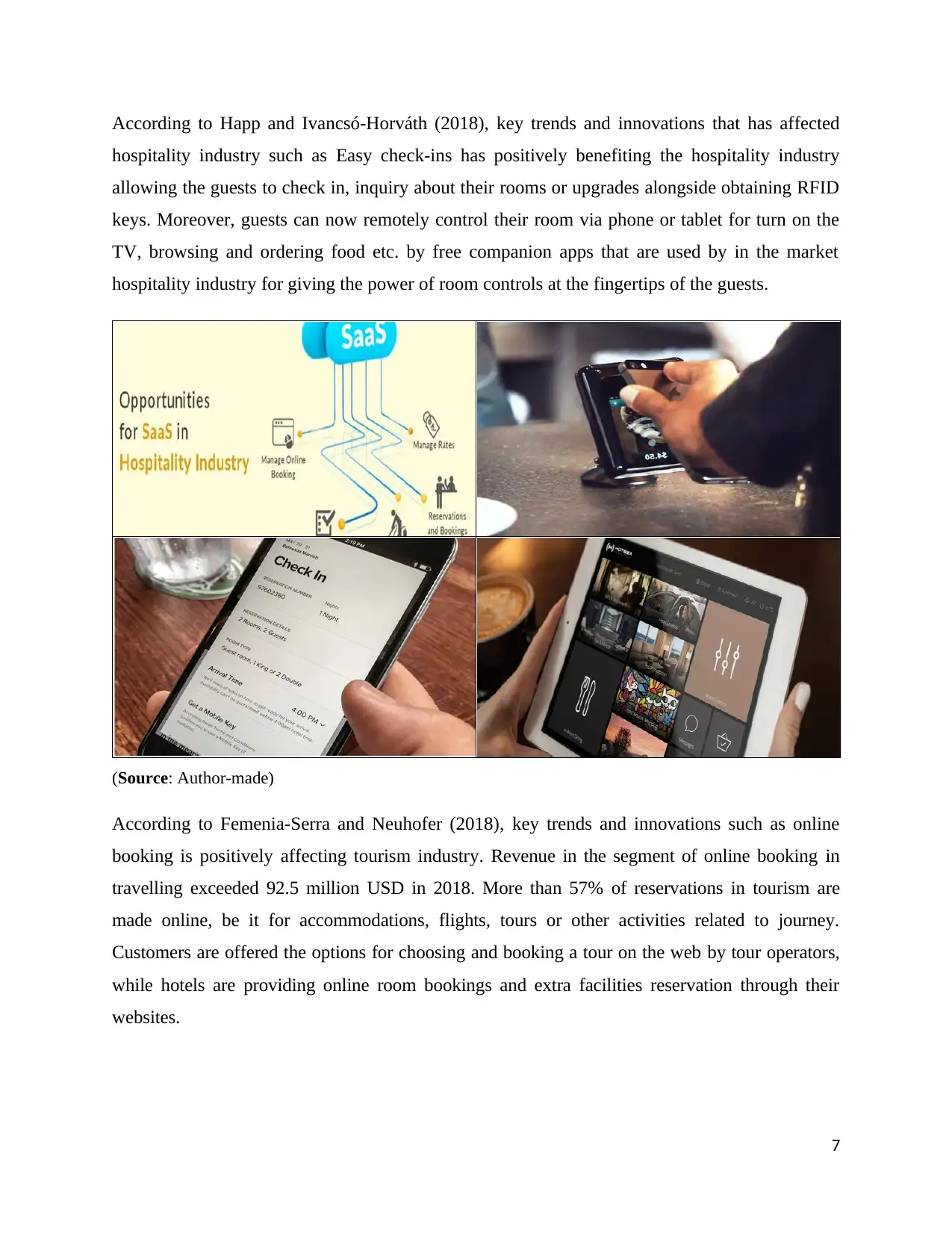
According to Happ and Ivancsó-Horváth (2018), key trends and innovations that has affected
hospitality industry such as Easy check-ins has positively benefiting the hospitality industry
allowing the guests to check in, inquiry about their rooms or upgrades alongside obtaining RFID
keys. Moreover, guests can now remotely control their room via phone or tablet for turn on the
TV, browsing and ordering food etc. by free companion apps that are used by in the market
hospitality industry for giving the power of room controls at the fingertips of the guests.
(Source: Author-made)
According to Femenia-Serra and Neuhofer (2018), key trends and innovations such as online
booking is positively affecting tourism industry. Revenue in the segment of online booking in
travelling exceeded 92.5 million USD in 2018. More than 57% of reservations in tourism are
made online, be it for accommodations, flights, tours or other activities related to journey.
Customers are offered the options for choosing and booking a tour on the web by tour operators,
while hotels are providing online room bookings and extra facilities reservation through their
websites.
7
hospitality industry such as Easy check-ins has positively benefiting the hospitality industry
allowing the guests to check in, inquiry about their rooms or upgrades alongside obtaining RFID
keys. Moreover, guests can now remotely control their room via phone or tablet for turn on the
TV, browsing and ordering food etc. by free companion apps that are used by in the market
hospitality industry for giving the power of room controls at the fingertips of the guests.
(Source: Author-made)
According to Femenia-Serra and Neuhofer (2018), key trends and innovations such as online
booking is positively affecting tourism industry. Revenue in the segment of online booking in
travelling exceeded 92.5 million USD in 2018. More than 57% of reservations in tourism are
made online, be it for accommodations, flights, tours or other activities related to journey.
Customers are offered the options for choosing and booking a tour on the web by tour operators,
while hotels are providing online room bookings and extra facilities reservation through their
websites.
7
Paraphrase This Document
Need a fresh take? Get an instant paraphrase of this document with our AI Paraphraser
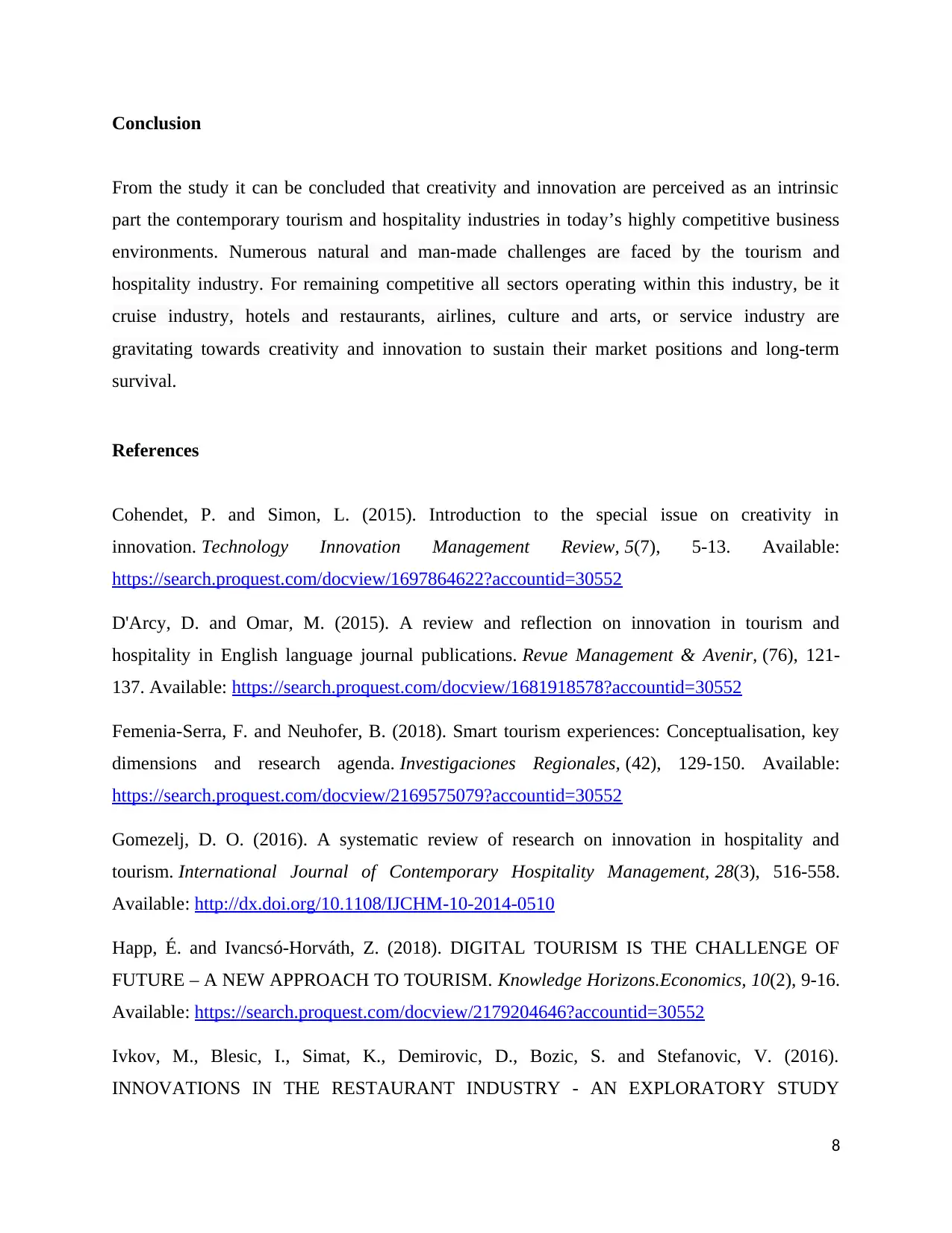
Conclusion
From the study it can be concluded that creativity and innovation are perceived as an intrinsic
part the contemporary tourism and hospitality industries in today’s highly competitive business
environments. Numerous natural and man-made challenges are faced by the tourism and
hospitality industry. For remaining competitive all sectors operating within this industry, be it
cruise industry, hotels and restaurants, airlines, culture and arts, or service industry are
gravitating towards creativity and innovation to sustain their market positions and long-term
survival.
References
Cohendet, P. and Simon, L. (2015). Introduction to the special issue on creativity in
innovation. Technology Innovation Management Review, 5(7), 5-13. Available:
https://search.proquest.com/docview/1697864622?accountid=30552
D'Arcy, D. and Omar, M. (2015). A review and reflection on innovation in tourism and
hospitality in English language journal publications. Revue Management & Avenir, (76), 121-
137. Available: https://search.proquest.com/docview/1681918578?accountid=30552
Femenia-Serra, F. and Neuhofer, B. (2018). Smart tourism experiences: Conceptualisation, key
dimensions and research agenda. Investigaciones Regionales, (42), 129-150. Available:
https://search.proquest.com/docview/2169575079?accountid=30552
Gomezelj, D. O. (2016). A systematic review of research on innovation in hospitality and
tourism. International Journal of Contemporary Hospitality Management, 28(3), 516-558.
Available: http://dx.doi.org/10.1108/IJCHM-10-2014-0510
Happ, É. and Ivancsó-Horváth, Z. (2018). DIGITAL TOURISM IS THE CHALLENGE OF
FUTURE – A NEW APPROACH TO TOURISM. Knowledge Horizons.Economics, 10(2), 9-16.
Available: https://search.proquest.com/docview/2179204646?accountid=30552
Ivkov, M., Blesic, I., Simat, K., Demirovic, D., Bozic, S. and Stefanovic, V. (2016).
INNOVATIONS IN THE RESTAURANT INDUSTRY - AN EXPLORATORY STUDY
8
From the study it can be concluded that creativity and innovation are perceived as an intrinsic
part the contemporary tourism and hospitality industries in today’s highly competitive business
environments. Numerous natural and man-made challenges are faced by the tourism and
hospitality industry. For remaining competitive all sectors operating within this industry, be it
cruise industry, hotels and restaurants, airlines, culture and arts, or service industry are
gravitating towards creativity and innovation to sustain their market positions and long-term
survival.
References
Cohendet, P. and Simon, L. (2015). Introduction to the special issue on creativity in
innovation. Technology Innovation Management Review, 5(7), 5-13. Available:
https://search.proquest.com/docview/1697864622?accountid=30552
D'Arcy, D. and Omar, M. (2015). A review and reflection on innovation in tourism and
hospitality in English language journal publications. Revue Management & Avenir, (76), 121-
137. Available: https://search.proquest.com/docview/1681918578?accountid=30552
Femenia-Serra, F. and Neuhofer, B. (2018). Smart tourism experiences: Conceptualisation, key
dimensions and research agenda. Investigaciones Regionales, (42), 129-150. Available:
https://search.proquest.com/docview/2169575079?accountid=30552
Gomezelj, D. O. (2016). A systematic review of research on innovation in hospitality and
tourism. International Journal of Contemporary Hospitality Management, 28(3), 516-558.
Available: http://dx.doi.org/10.1108/IJCHM-10-2014-0510
Happ, É. and Ivancsó-Horváth, Z. (2018). DIGITAL TOURISM IS THE CHALLENGE OF
FUTURE – A NEW APPROACH TO TOURISM. Knowledge Horizons.Economics, 10(2), 9-16.
Available: https://search.proquest.com/docview/2179204646?accountid=30552
Ivkov, M., Blesic, I., Simat, K., Demirovic, D., Bozic, S. and Stefanovic, V. (2016).
INNOVATIONS IN THE RESTAURANT INDUSTRY - AN EXPLORATORY STUDY
8
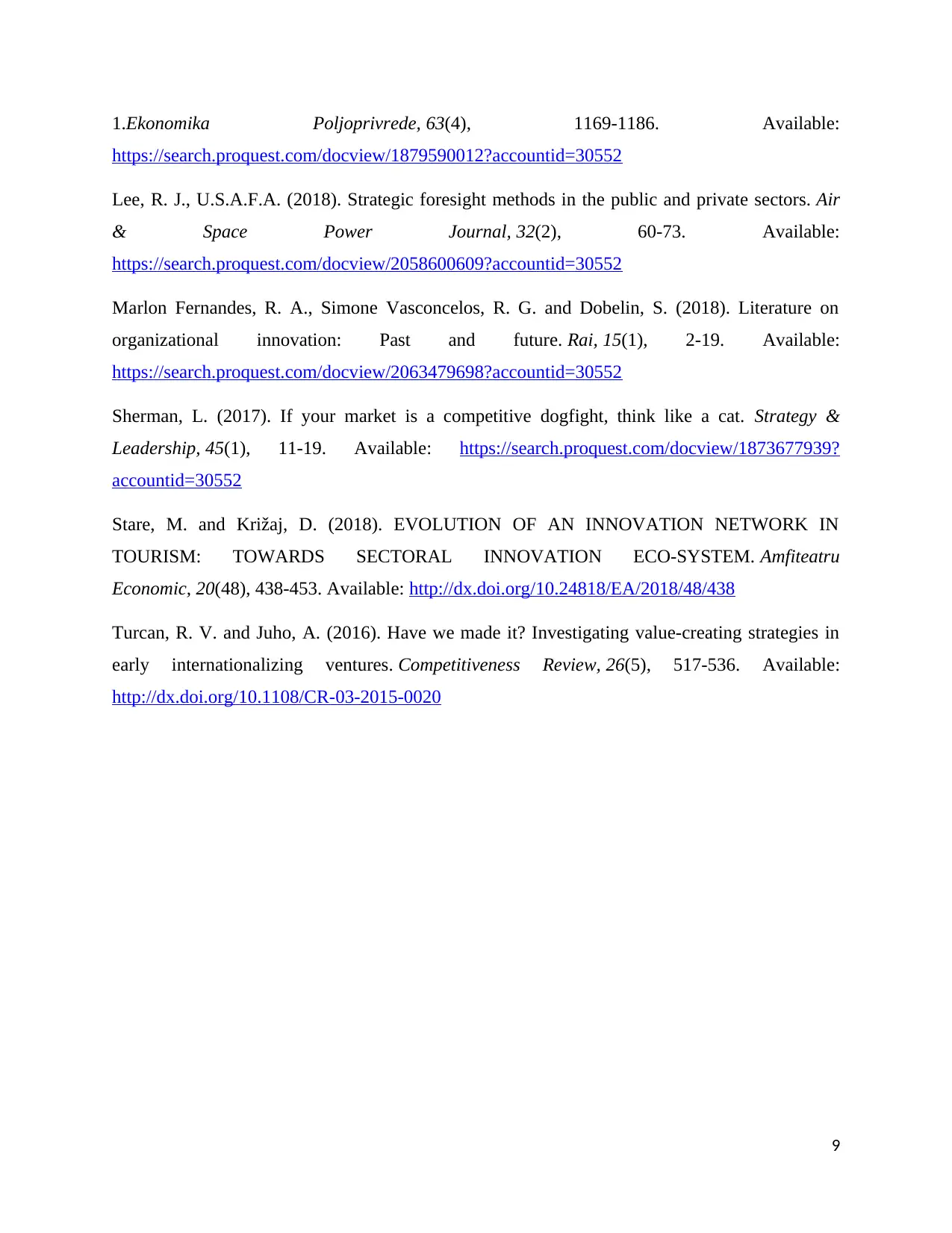
1.Ekonomika Poljoprivrede, 63(4), 1169-1186. Available:
https://search.proquest.com/docview/1879590012?accountid=30552
Lee, R. J., U.S.A.F.A. (2018). Strategic foresight methods in the public and private sectors. Air
& Space Power Journal, 32(2), 60-73. Available:
https://search.proquest.com/docview/2058600609?accountid=30552
Marlon Fernandes, R. A., Simone Vasconcelos, R. G. and Dobelin, S. (2018). Literature on
organizational innovation: Past and future. Rai, 15(1), 2-19. Available:
https://search.proquest.com/docview/2063479698?accountid=30552
Sherman, L. (2017). If your market is a competitive dogfight, think like a cat. Strategy &
Leadership, 45(1), 11-19. Available: https://search.proquest.com/docview/1873677939?
accountid=30552
Stare, M. and Križaj, D. (2018). EVOLUTION OF AN INNOVATION NETWORK IN
TOURISM: TOWARDS SECTORAL INNOVATION ECO-SYSTEM. Amfiteatru
Economic, 20(48), 438-453. Available: http://dx.doi.org/10.24818/EA/2018/48/438
Turcan, R. V. and Juho, A. (2016). Have we made it? Investigating value-creating strategies in
early internationalizing ventures. Competitiveness Review, 26(5), 517-536. Available:
http://dx.doi.org/10.1108/CR-03-2015-0020
9
https://search.proquest.com/docview/1879590012?accountid=30552
Lee, R. J., U.S.A.F.A. (2018). Strategic foresight methods in the public and private sectors. Air
& Space Power Journal, 32(2), 60-73. Available:
https://search.proquest.com/docview/2058600609?accountid=30552
Marlon Fernandes, R. A., Simone Vasconcelos, R. G. and Dobelin, S. (2018). Literature on
organizational innovation: Past and future. Rai, 15(1), 2-19. Available:
https://search.proquest.com/docview/2063479698?accountid=30552
Sherman, L. (2017). If your market is a competitive dogfight, think like a cat. Strategy &
Leadership, 45(1), 11-19. Available: https://search.proquest.com/docview/1873677939?
accountid=30552
Stare, M. and Križaj, D. (2018). EVOLUTION OF AN INNOVATION NETWORK IN
TOURISM: TOWARDS SECTORAL INNOVATION ECO-SYSTEM. Amfiteatru
Economic, 20(48), 438-453. Available: http://dx.doi.org/10.24818/EA/2018/48/438
Turcan, R. V. and Juho, A. (2016). Have we made it? Investigating value-creating strategies in
early internationalizing ventures. Competitiveness Review, 26(5), 517-536. Available:
http://dx.doi.org/10.1108/CR-03-2015-0020
9
⊘ This is a preview!⊘
Do you want full access?
Subscribe today to unlock all pages.

Trusted by 1+ million students worldwide
1 out of 9
Related Documents
Your All-in-One AI-Powered Toolkit for Academic Success.
+13062052269
info@desklib.com
Available 24*7 on WhatsApp / Email
![[object Object]](/_next/static/media/star-bottom.7253800d.svg)
Unlock your academic potential
Copyright © 2020–2025 A2Z Services. All Rights Reserved. Developed and managed by ZUCOL.





